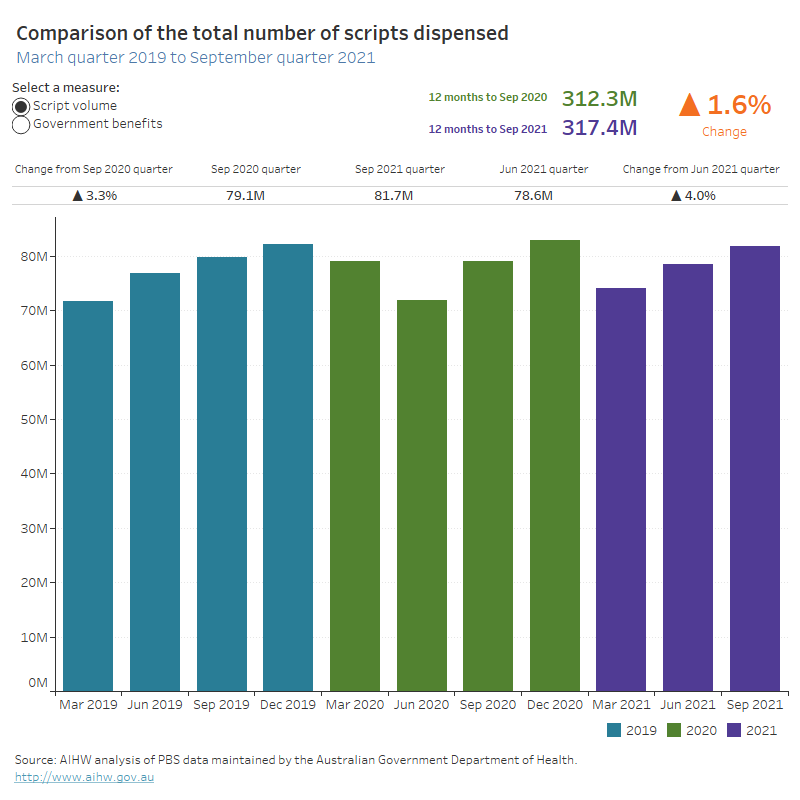Impact on PBS service utilisation
In response to the pandemic, a number of temporary changes to prescribing and dispensing of PBS medicines were implemented. These changes were aimed at minimising the risk of prescribing doctors, dispensing pharmacists and consumers contracting COVID-19 while ensuring efficient supply of medicines and consumers could have continued access to their medications. These included:
- supply of a consumer’s usual medicine without consumers physically visiting a doctor for a prescription (extension of continued dispensing arrangements)
- image based prescriptions to support Medicare telehealth services and supply of medicines to consumers
- exemptions from PBS restriction requirements for certain medicines to consumers who have been previously prescribed the medication (from 1 May 2020)
- simplified prescribing arrangements for chemotherapy consumers from multiple paper prescriptions to a single chemotherapy medication chart (from 20 August 2020)
- alternative medicine arrangements for existing consumers to account for the shortage of tocilizumab (a type of severe arthritis medication), due to off-label use in COVID-19 treatment (from 15 August 2021). Tocilizumab is used to treat severe rheumatoid arthritis, juvenile idiopathic arthritis and giant cell arteritis.
For the quarter ending September 2021 points of note are:
Compared with the quarter ending June 2021
- The number of prescriptions dispensed was 4.0% higher in the quarter ending September 2021 (81.7 million) than the quarter ending June 2021 (78.6 million). This increase could be partly attributed to medicine seasonality (for example prescriptions for antibiotics are usually higher in winter).
Compared with the quarter ending September 2020
- There was an increase of 3.3% in the number of prescriptions dispensed, from 79.1 million to 81.7 million.
- There were concerns that existing consumers of tocilizumab would be impacted by the global shortage of the medicine. However, the number of prescriptions dispensed for tocilizumab increased by 1.8% from almost 15,900 to 16,100 indicating that supply issues had not yet eventuated and exemption arrangements put in place in May 2020 to ensure continuity of supply were successful. The effect from the global shortage of the medicine and increase in demand for its replacement medicines may be observable in the next quarter.
- There was a 6.8% increase in the number of prescriptions dispensed for antineoplastic and immunomodulating agents (this group of medicines are used to treat conditions such as cancer or arthritis) from 1.3 million to 1.4 million.
- The number of original and repeat prescriptions dispensed at the same time rose by 16.3%, from around 389,000 to 452,000. This rise may be due to an increase in demand for domestic and overseas travel, as a result of high vaccination rates against COVID-19 and the easing of border restrictions.
- The lockdowns in New South Wales, Victoria and the Australian Capital Territory in the September 2021 quarter appeared to have had minimal impact on consumer access to medicines, with an increase in prescription volume of 0.8% to nearly 26 million, 4.3% to 20.4 million, and 5.6% to 1.2 million respectively.
- Victoria experienced lockdowns in both the September 2020 and 2021 quarters. Compared to the September quarter of 2019, there was a slight decrease of 1.7% to 19.6 million prescriptions dispensed in the September quarter 2020 and a 4.3% growth in the September quarter 2021 over the same quarter in 2020.
Comparing the year ending September 2021 with the year ending September 2020
- There was a 1.6% increase in the number of prescriptions dispensed, from 312.3 million to 317.4 million.
- The General schedule, the largest program for medicines dispensed through community pharmacies, had a 1.6% increase in prescription volume from 304.6 million to 309.6 million. The pandemic appears to have had little effect on consumer access to medicines from community pharmacies in terms of national figures.
- Highly Specialised Drugs and Efficient Funding of Chemotherapy are two major programs that provide medicines mostly in tertiary care facilities such as hospitals. Prescriptions dispensed for these two programs were consistently higher in each quarter compared to the same quarter in the previous year. Prescription volume of the Highly Specialised Drugs increased by 6.2% from 1.5 million to 1.6 million and the Efficient Funding of Chemotherapy increased by 6.0% from 1.2 million to 1.3 million, showing that the pandemic has had minimal impact on the volumes of these medications. Interim measures such as the simplified prescribing arrangements for chemotherapy consumers were introduced to support the prescribing and supply of medicines for chemotherapy patients amidst the COVID-19 pandemic.
- Comparing the number of original prescriptions to repeats, the ratio of original prescriptions remained the same at 40% (repeats 60%). This consistency suggests that the pandemic did not have much effect on how consumers accessed their medicines, via first time dispensing of a prescription or a subsequent refill from an original prescription.
The above national patterns were broadly similar for all states and territories.
This data visualisation provides an overview of PBS prescriptions dispensed and government benefits paid during the pandemic in March 2020 to September 2021 and prior to the pandemic back to 2019. Prescription volumes by state and territory are presented for: Greater capital cities and rest of state/territory areas, original and repeat prescriptions, prescriptions dispensed concurrently, PBS programs, Anatomical Therapeutic Classification (ATC) groups and tocilizumab.

Note: Quarters of a calendar year are used in the report. For example: Sep 2021 or September quarter 2021 refers to July to September 2021, which is the first quarter of FY 2021-2022.


